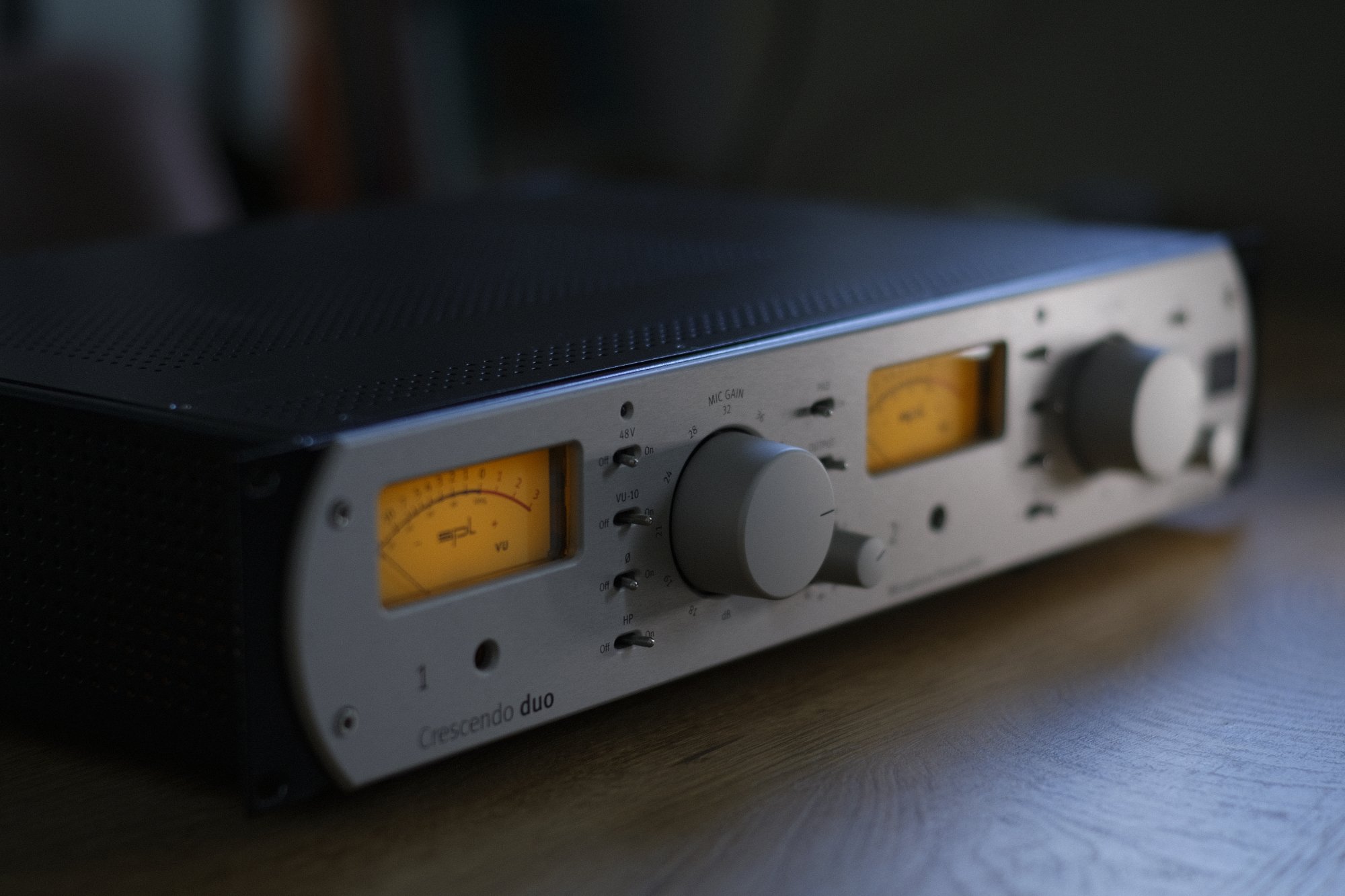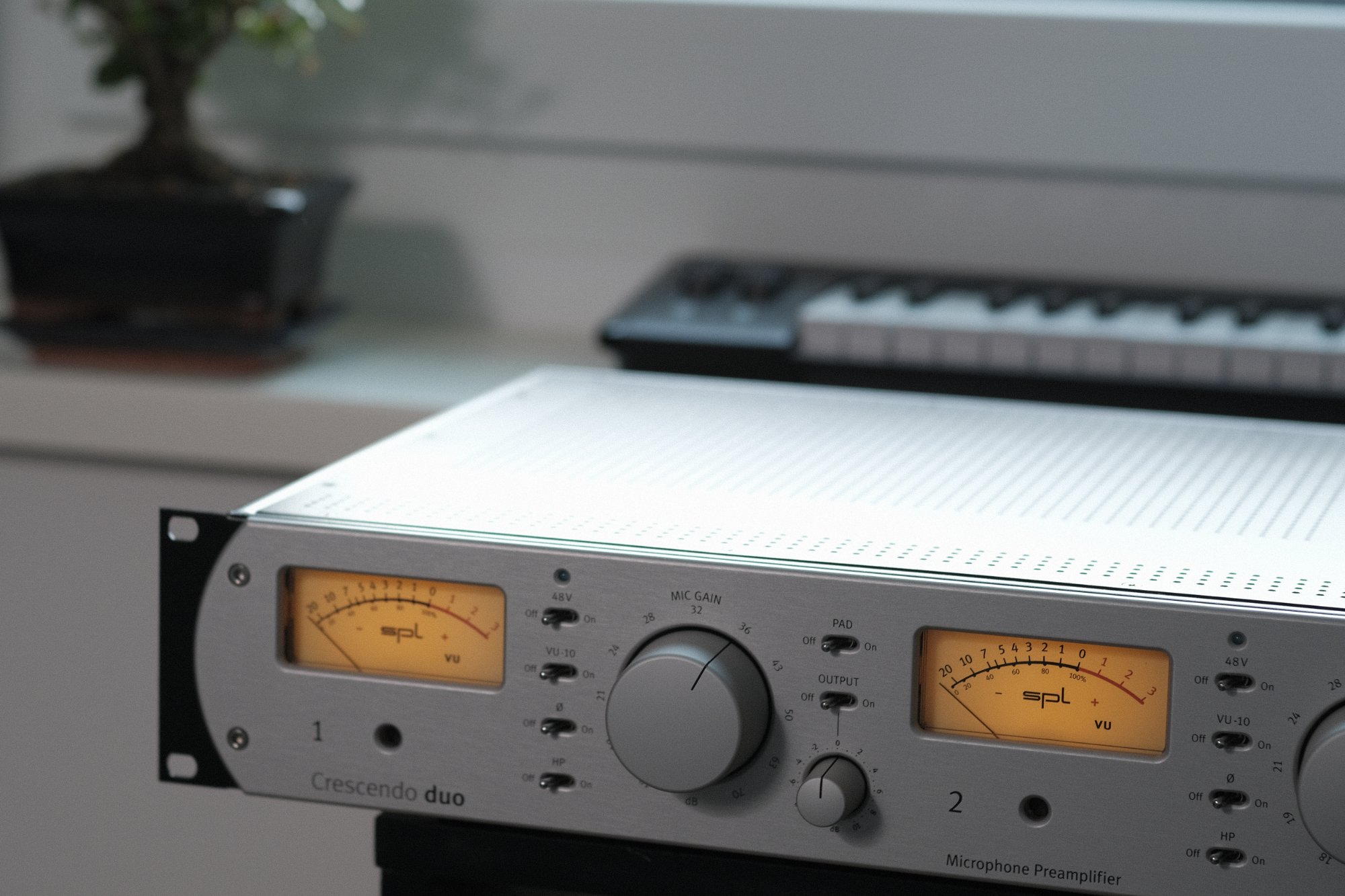SPL Crescendo duo Microphone Preamplifier Review
Gorgeously clean gain for your microphones
High-quality preamps that can capture all the nuances and subtleties of classical guitar are not as common as one might think, as most designs introduce too much noise and colour. When I came across the SPL Crescendo duo microphone preamp last year, I was intrigued by its specially designed 120-volt technology, which promises a particularly neutral, dynamic and low-distortion sound. I immediately contacted SPL and they sent me a demo unit to test.
Sound Performance Lab
SPL (Sound Performance Lab) is a German company that has been manufacturing professional audio equipment for about 40 years. SPL is known for its innovative designs and audio solutions of the highest quality. Their preamps, converters and headphone amplifiers are used in recording studios for music and film worldwide. Common features of all SPL products are the impressive build quality and enormous size.
SPL Crescendo duo Microphone Preamp
The Crescendo
The Crescendo 120-volt rail preamp design was introduced with the original 8-channel unit; the duo, as the name implies, is the stereo version, ideal for recording classical guitar in situations where good enough is not enough.
One of the ftings that sets the SPL Crescendo duo apart is its large knobs and tactile switches. Each channel provides from +18 dB to +70 dB of gain, which can be independently increased or decreased by 10 dB with a switchable output control. In this way, the rest of the chain can be supplied with an optimal level. The total output can reach up to 80 dB, which is more than sufficient for even the weakest ribbon microphones.
The physical VU meters for level adjustment leave a remarkable impression and can lower the displayed level by 10 dB if necessary. A high-pass filter of 6 dB per octave at 120 Hz is quite useful, although I would prefer it to be switchable for greater versatility. Nonetheless, every aspect of the Crescendo duo has been carefully thought out.
SPL Crescendo duo - tactile switches and VU meters
Four times more voltage
The 120 V technology operates at +/- 60 V. To handle such a high voltage, SPL has developed special proprietary operational amplifiers (SUPRA) that can operate at a such high voltages, as this would destroy conventional components and operational amplifiers.
How it sounds
After using the Crescendo duo in my recording setup for a couple of months, I am happy to report that it exceeded my expectations. The SPL has a very clean and transparent sound, which is essential when recording classical guitars. Many preamps introduce colouration and distortion that can detract from the subtleties and nuances of the recording. The result can sometimes be pleasant, but it strays far from the original sound and is usually not what we are looking for when trying to capture luthier-grade guitars and world-class guitarists. It's worth noting that unlike other clean preamps, the Crescendo is not a bit shrill, but has an overall smooth and warm sound.
A high-end setup & ‘The Music of the Impressionists’
I used the SPL Crescendo duo to record my latest album, The Music of the Impressionists, which contains a wealth of tonal colours, sustained tones, great dynamic differences, and silences. I used my beloved Essense guitar, handcrafted by Angela Waltner in Berlin, and in conjunction with a pair of Gefell M 950 microphones (review coming soon), another marvel of German engineering, and the RME ADI-2 Pro FS for the analogue-to-digital conversion, the Crescendo captured every detail brilliantly.
Listen to ‘The Music of the Impressionists’ on Spotify:
Comparisons
SPL Crescendo duo vs AEA TRP2
The Crescendo duo is similar in many ways to the AEA TRP2, another highly regarded preamp that I have used for several years. Both units are known for their clean and transparent sound, and both have low self-noise and high maximum gain. However, the Crescendo has a bit more refinement, smoothness and realism in its sound. The sonic benefits, additional features, and fantastic build quality of the preamp are worth the price difference. However, I will also keep the AEA TRP2 for some field recordings, as it is easier to transport.
Some thoughts on microphone preamps
Most audio interfaces have adequate preamps for most applications and users. So unless every other aspect of your recording chain is well thought out, searching for microphone preamps is a futile endeavour. The differences between clean mic preamps are only subtle but can become important when combined with other competent equipment and production skills. If you are confident in your setup and all you are missing is a good mic preamp, I'd suggest forgoing cheap deals and saving up until you can afford a high-end preamp like the Crescendo duo.
The Coda
The SPL Crescendo duo microphone preamp is one of the best options for recording classical guitar. It is a well-designed and sophisticated device that is capable of producing excellent recordings and is made to last a lifetime.
AEA TRP2 Microphone Preamp Review
A black canvas for your acoustic paintings.
AEA designed "The Ribbon Preamp" to guarantee the best operation for their ribbon microphones. Equipped with +48 phantom, the TRP2 can power condenser and active ribbon microphones.
Built for the desk and the road
A simple but effective layout.
With retro looks and an elegant grey finish, I think it looks great on a rack or a desktop. Housed in a lightweight half-rack aluminium chassis, the TRP2 is fairly portable though, perfectly fitting on a remote recording session.
The TRP2 has two-channels with 85dB gain for stereo capture. Each one is equipped with a stepped gain stage (+7dB to +63dB) and variable output control (+22dB) for fine-tuning. Push buttons for phase reverse, a low-cut filter (12dB per octave from 100Hz) and +48 phantom, as well as 3 led level indicators per channel, are located in the front panel.
The preamp is powered by an external PSU that is connected to the rear panel where four XLRs are located as well. Two for the microphone inputs and two for the line outputs. No quarter-inch outputs for unbalanced connections, neither a DI input are available. AEA built a high-quality microphone preamp equipped with only the absolute essentials.
Fade to black
Huge amounts of clean gain.
The sound of the preamp is remarkably transparent and natural, with a very fast transient response for excellent dynamics. With ease, the TPR2 manages to pick up unsurpassed detail out of my classical guitar, while allowing a full-bodied portrayal, with a beautiful midrange, pleasing highs and controlled low-end.
One of the most alluring characteristics of the TRP2 is the incredibly quiet operation. The classical guitar, being a soft and subtle instrument, presents a challenge to record properly. The signal path, designed by Fred Forsell, is evident, the TRP2 maintains every detail and lets the notes fade out to total silence.
The operation of the TRP2 is straight forward and a neatly written manual includes plenty of useful information. The level indicator LED are sufficient for discerning that the levels are healthy. I think that the low-cut filters are set a little too high for my uses, but other than I have no complaints.
Can you handle the truth?
Precise control.
AEA's preamps don't try to complement the source. The true strength of the TRP2 lies in allowing the microphones to capture an honest image with exceptional precision. With an impressive 85dB of absolute clean gain, the preamp ensures outstanding performance and can capture even the quietest sounds.
Alternatives
Priced a little lower, the DAV BG1 is an acclaimed preamp with a similar feature-set, low noise and high quality. In comparison, its sound is somewhat coloured, but that is neither good or bad. Lake people's MPA RS 01 is a straight-wire preamp in a similar form and function, worthy of consideration.
Cons
Low-cut filters are set a little too high for some uses
Pros
Beautiful sound, from top to bottom
Detailed, transparent, and natural sounding
Impressive amounts of gain
Very low noise
Lightweight and portable Sturdy construction
Some classical guitar recordings made with the AEA TRP2:







